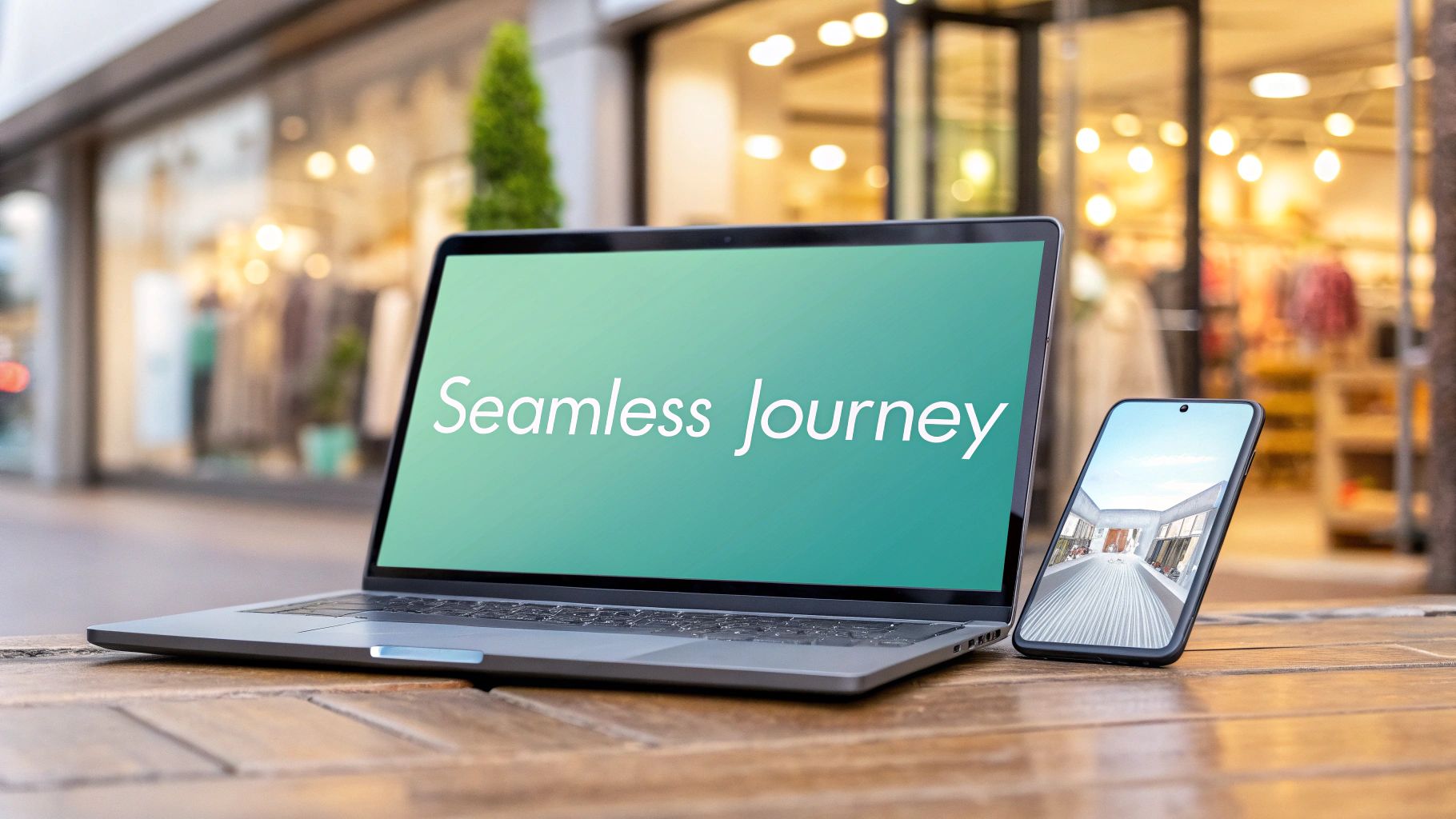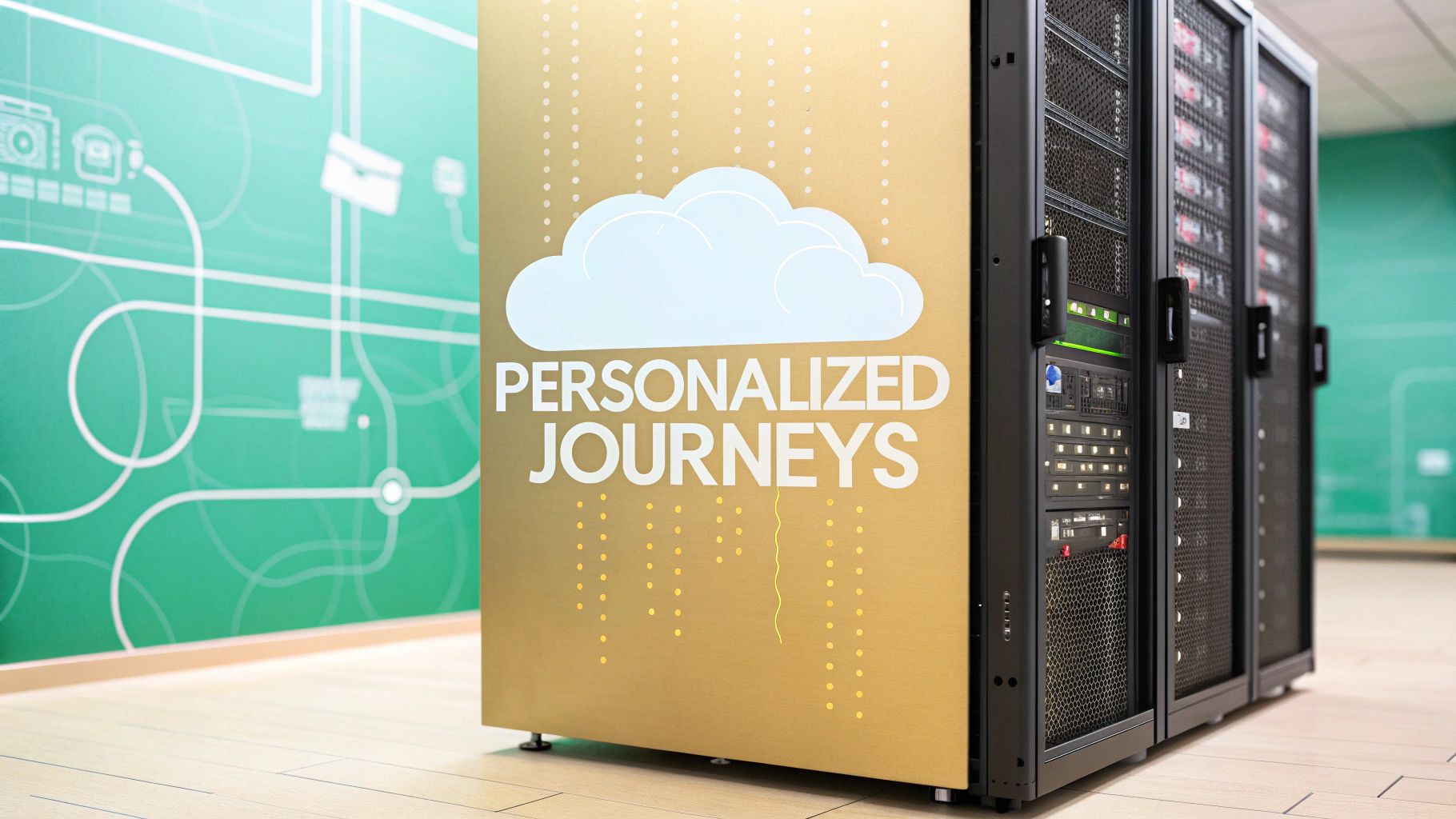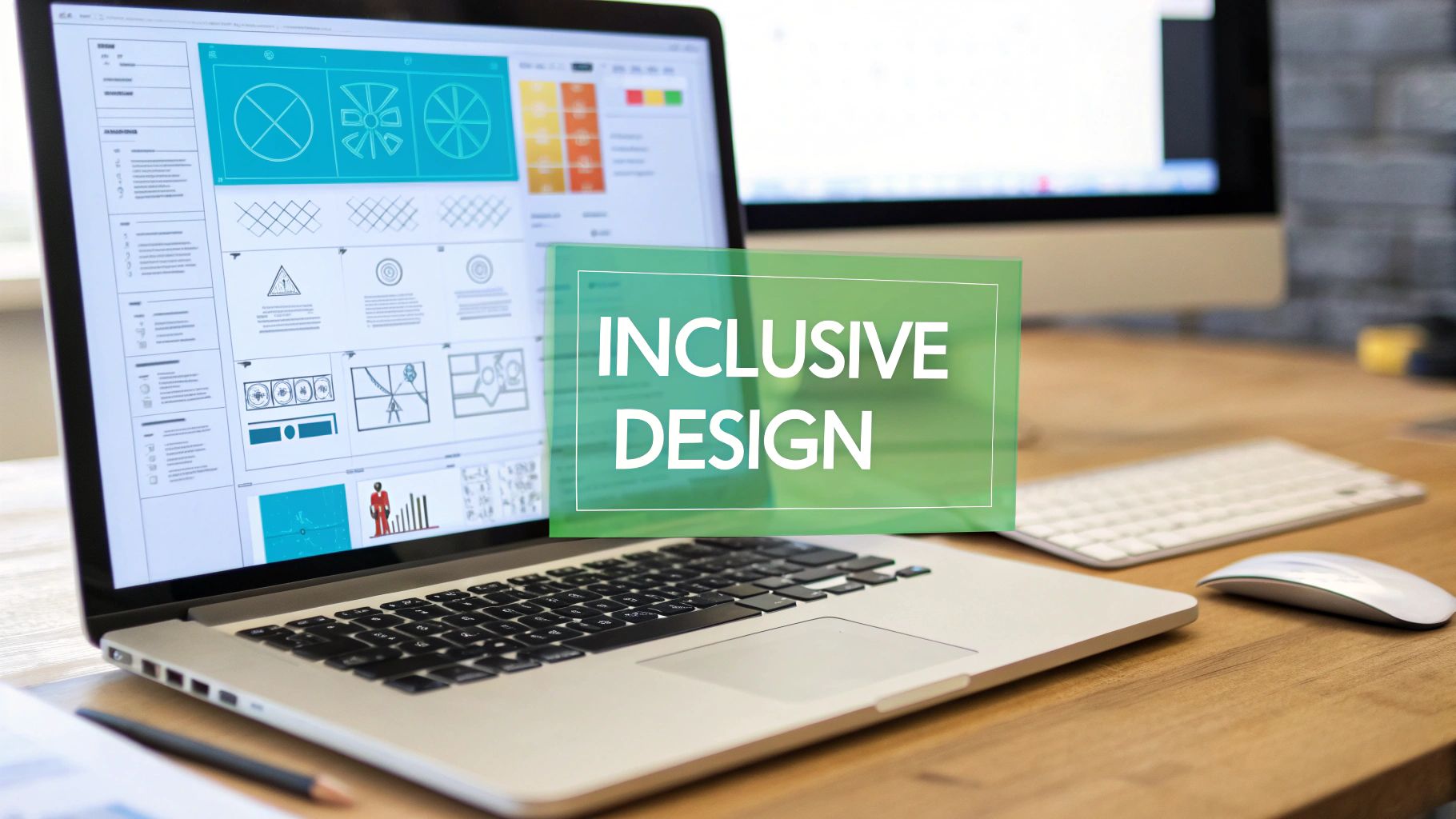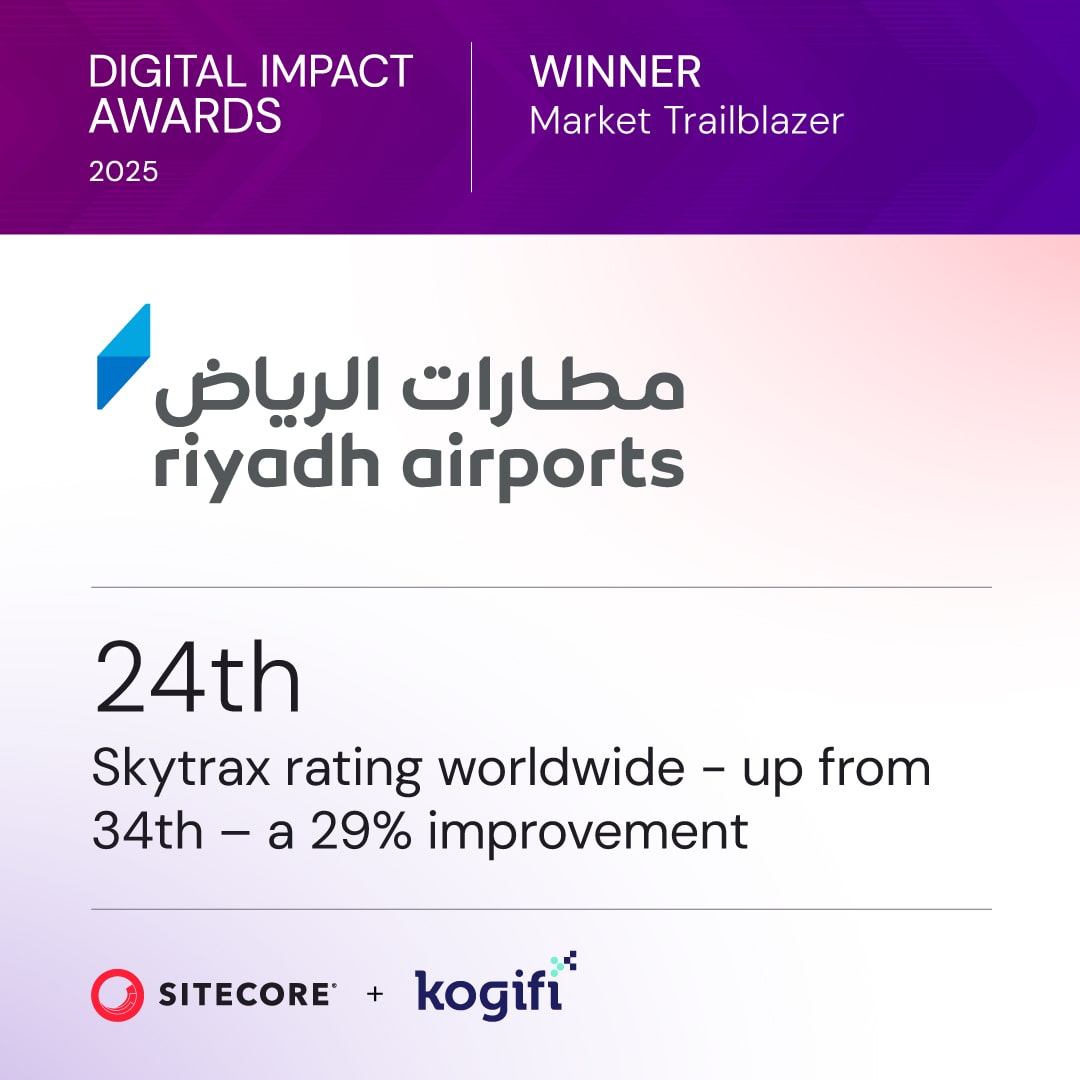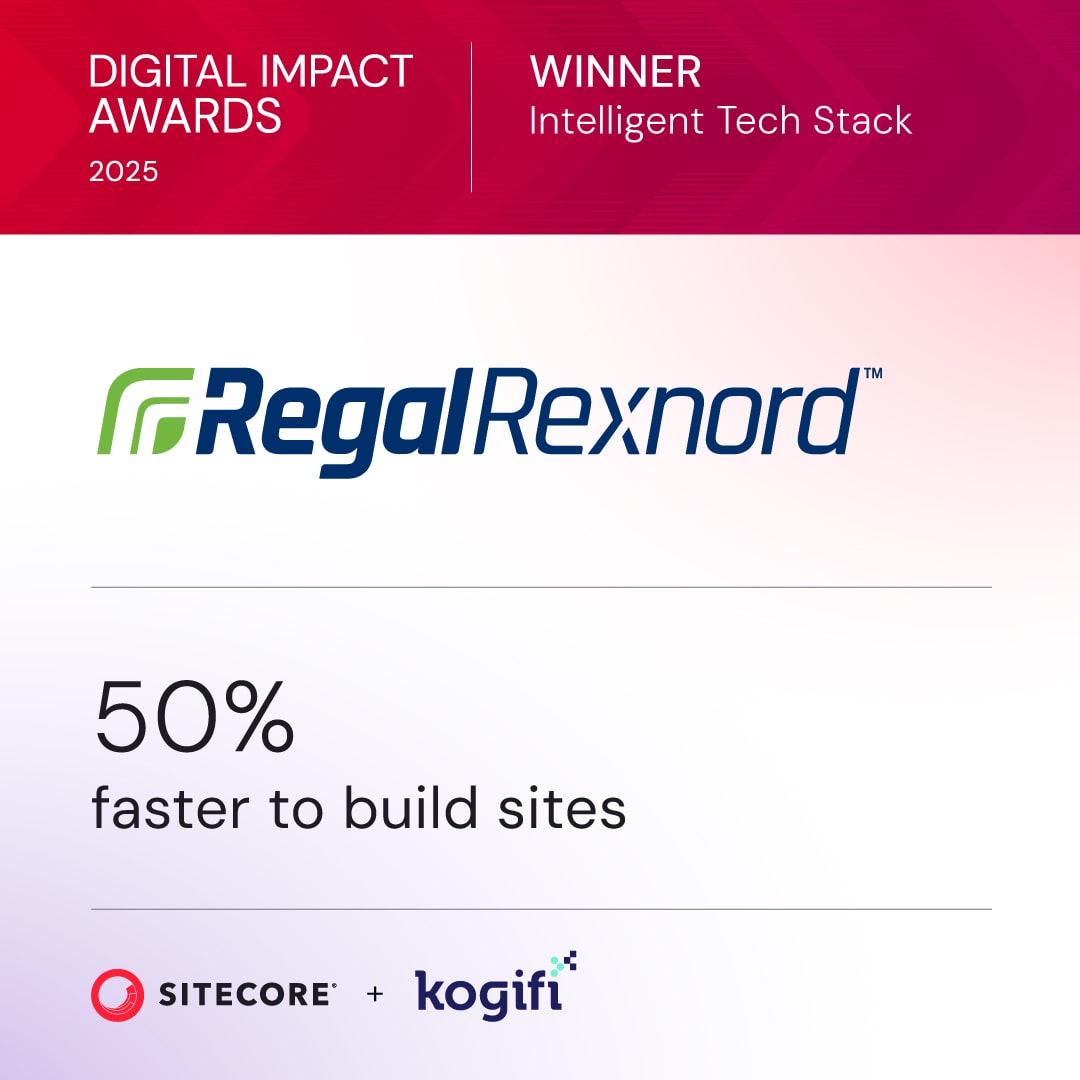Imagine this: a customer adds a pair of shoes to their shopping cart on their phone during the morning commute. At lunch, they ask a chatbot on their laptop a quick question about sizing. Later that day, they walk into your store, and an associate greets them, already aware of the shoes they were looking at.
That’s the essence of an omnichannel experience. It’s a single, continuous conversation with a brand that flows seamlessly across every touchpoint, making each interaction feel like it’s simply picking up where the last one left off.
What Is the Modern Omnichannel Experience
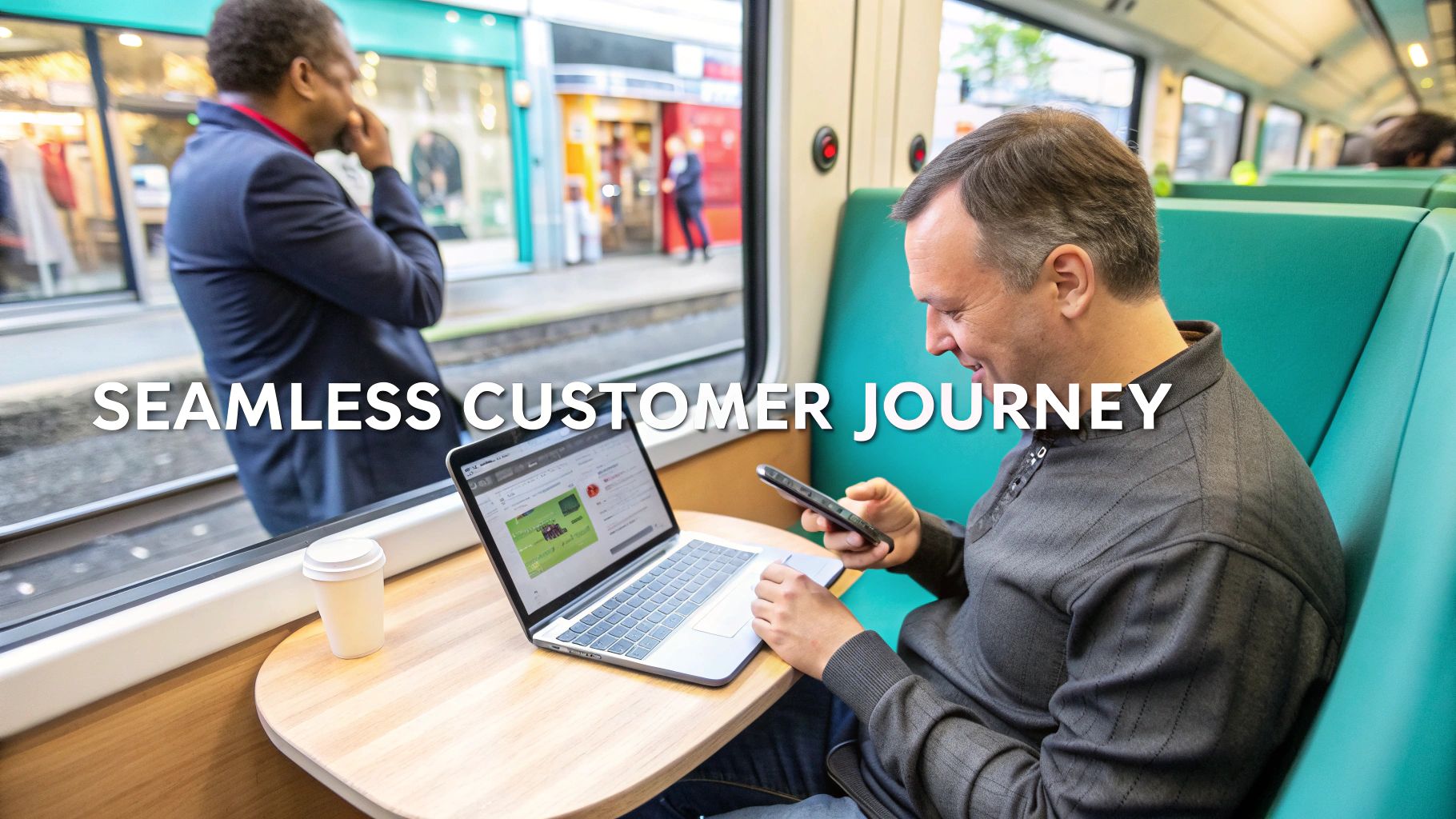
At its heart, the omnichannel experience is a customer-first model where every channel is deeply woven together. Don’t think of it as a collection of separate paths—a website, an app, a physical store. Instead, picture it as a single, intelligent ecosystem built around the customer.
This approach treats every customer as one individual, no matter how they choose to connect with you. Their history, preferences, and context follow them from one channel to the next, which gets rid of the friction of having to start over. A platform like Sitecore is designed to make this unified conversation possible by bringing all that customer data into one place.
The Power of a Unified Conversation
The real magic of a winning omnichannel marketing strategy is its ability to unify customer data. This is where Sitecore's product suite really makes a difference. By using a Customer Data Platform (CDP), every single interaction—every click, every chat, every purchase—is captured and pulled into a single customer profile. That profile becomes the source of truth for every other system.
This unified view makes powerful personalization and consistency possible:
- Contextual Awareness: Your website knows what a customer was just browsing on the mobile app.
- Seamless Transitions: A customer service agent can see the exact items left in an abandoned online cart.
- Predictive Engagement: AI can start anticipating a customer's needs based on their behavior across all channels.
An omnichannel experience removes the frustrating need for customers to reintroduce themselves at every turn. Instead of fragmented interactions, it creates a coherent dialogue that makes customers feel recognized and understood.
From Concept to Reality
Making this happen takes more than just good intentions; it demands the right technology. Platforms like Sitecore and integrated solutions like SharePoint provide the necessary backbone. Sitecore orchestrates the external customer journey, while SharePoint can empower your internal teams with the consistent information they need to deliver on that brand promise.
The results are striking. Companies that get omnichannel right report a customer satisfaction score of 67%, more than double the 28% seen by businesses with disconnected channels. This makes sense when you learn that 56% of customers say they have to repeat themselves across different touchpoints—a major frustration that omnichannel is built to solve.
Ultimately, this integration doesn't just improve engagement; it boosts customer loyalty by up to 35%.
Omnichannel vs. Multichannel: Understanding the Difference
It’s easy to think that just because you have a website, a mobile app, and a few social media profiles, you’re delivering an omnichannel experience. But in reality, what you have is a multichannel strategy—a collection of different channels that operate in their own little silos.
Think of a multichannel setup like a house with plenty of doors, but no hallways connecting the rooms. If you want to get from the kitchen to the living room, you have to step outside and come back in through a different door. Each entry is a totally separate, disconnected event.
An omnichannel strategy, on the other hand, builds those connecting hallways. It weaves every channel together into a single, intelligent system that creates one continuous, seamless journey for the customer.
To really grasp the difference, let’s look at this comparison:
Omnichannel vs Multichannel Key Differences
This table breaks down the core distinctions between the two approaches, showing how they differ in everything from customer focus to the technology that powers them.
As you can see, the shift from multichannel to omnichannel is a fundamental change in mindset, moving from simply offering more options to creating a truly integrated experience.
The Customer Perspective
From a customer’s point of view, the difference is night and day. In a multichannel world, they’re forced to start their journey from scratch every single time they switch channels. If they add an item to their cart on your website, the mobile app has no idea it’s there. A conversation with a chatbot on social media is a complete mystery to the associate they meet in your store.
This fragmentation is the core issue that a true omnichannel experience solves. It shifts the focus from the channel itself to the customer's unified journey across all channels.
A genuine omnichannel strategy makes sure that context and history follow the customer wherever they go. For a deeper look into how this strategy works in practice, explore our detailed guide on what is omnichannel marketing.
The Technology That Connects the Dots
This kind of seamless integration doesn’t just happen by magic. It’s powered by a robust technological foundation that can collect, interpret, and act on customer data in real time. This is where platforms like Sitecore and internal tools like SharePoint become absolutely vital.
- Sitecore as the Central Nervous System: Think of Sitecore’s product suite as the brain of your operation. Its Customer Data Platform (CDP) pulls in data from every interaction—a click, a purchase, a chat—to build a single, unified profile for each customer. This profile then informs every channel, ensuring a consistent and personalized experience.
- SharePoint for Internal Alignment: While Sitecore manages the external customer journey, SharePoint can be used to get all your internal teams on the same page. It acts as a central library for product information, brand guidelines, and company policies, making sure that customer service agents and sales staff are always delivering consistent messaging.
One of the biggest differentiators here is the heavy reliance on maintaining a consistent brand voice across multiple channels. Without that consistency, the experience feels disjointed and confusing, no matter how connected the backend technology is.
At the end of the day, multichannel is about giving customers options. Omnichannel is about creating a single, cohesive experience. The first gives them multiple doors to enter, while the second builds an interconnected home where they always feel recognized, understood, and valued, no matter which room they’re in.
The Core Components of a Winning Omnichannel Strategy
A true omnichannel experience isn't something that just happens. It’s built on a deliberate technological and strategic foundation, all designed to put the customer right at the center of every single interaction. To make it work, you need specific, interconnected components working together perfectly. Using the Sitecore ecosystem as a blueprint, we can see exactly how this powerful engine comes to life.
This infographic paints a clear picture of the shift from isolated channels to a customer-centric, connected system.
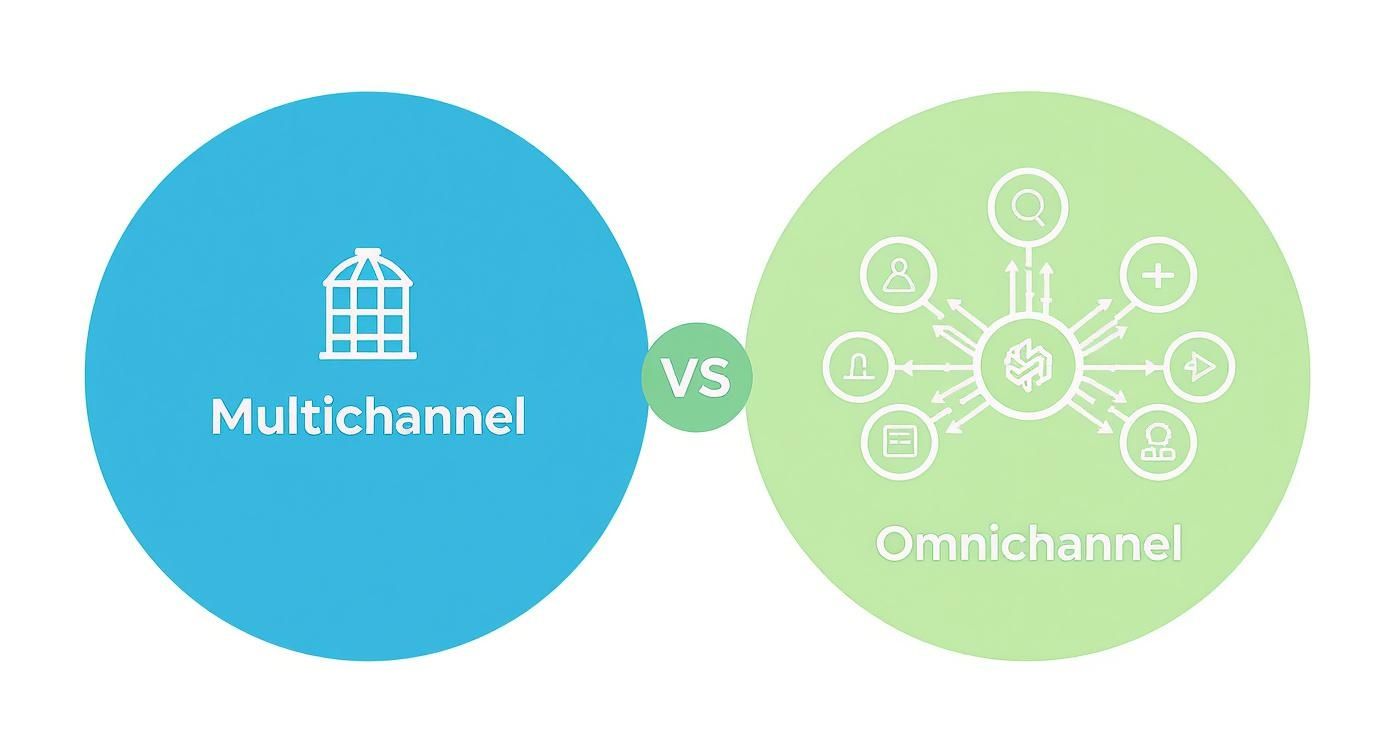
As the visual shows, omnichannel isn't just about having a bunch of touchpoints. It's about weaving them together around a single, unified view of the customer. Getting this distinction right is key to understanding what is omnichannel experience at its heart.
The Unified Customer Profile
The absolute cornerstone of any omnichannel strategy is the unified customer profile. Think of it as a single, living record of every interaction a customer has with your brand, no matter the channel. It’s what finally breaks down the data silos that so often hamstring multichannel marketing.
This is where a tool like the Sitecore Customer Data Platform (CDP) becomes non-negotiable. It acts as the central brain, pulling in data from your website, mobile app, in-store checkout, email campaigns—you name it. By piecing all this information together, Sitecore CDP creates that "single source of truth" you need for genuine personalization. Effective customer data integration solutions are the key to building this solid foundation.
A Headless CMS for Content Delivery
Once you have that unified profile, the next hurdle is getting consistent, personalized content out to all those channels. This is where a modern, headless CMS comes in. It cleverly separates the content itself (the "body") from how it’s displayed (the "head"), an architecture that is absolutely essential for omnichannel success.
Sitecore XM Cloud, a cloud-native, headless CMS, is built for this. It lets your marketing team create a piece of content just once and then push it out via APIs to any destination—a website, an app, a digital kiosk, or even a smart device. This ensures your brand messaging and offers stay consistent, no matter where a customer decides to engage.
Real-Time Personalization Engine
The final piece of the puzzle is the engine that actually uses all that unified data to create intelligent, context-aware experiences on the fly. This is the component that analyzes customer behavior and triggers personalized actions in the blink of an eye.
Sitecore Personalize is the decision-making engine that brings the data from Sitecore CDP to life. For example, it can:
- Trigger web personalizations based on something a customer bought in-store.
- Send a follow-up email if someone abandons a shopping cart on their mobile app.
- Serve up product recommendations that reflect a user's entire browsing history, not just what they did in the last five minutes.
This kind of deep integration perfectly mirrors how people shop today. The modern buying journey involves an average of six different touchpoints, with 73% of shoppers using multiple channels to complete a purchase. They research online before hitting the store (83%) and use their phones while walking the aisles (72%), proving just how blurred the lines between digital and physical have become.
Ultimately, these three components—unified data, headless content, and real-time personalization—don’t just coexist; they form a tightly integrated system. Together, they transform a series of disjointed touchpoints into a single, seamless conversation that makes customers feel like you truly get them.
Building Your Omnichannel Foundation with Sitecore
Turning the concept of an omnichannel experience into reality isn't just a great idea—it demands a powerful, flexible tech stack. This is where Sitecore's composable Digital Experience Platform (DXP) comes in, offering a clear path forward. Instead of forcing you into a rigid, one-size-fits-all box, a composable architecture lets you pick and choose best-in-class tools, creating a central hub for all your customer data and content.
The goal here is to build an ecosystem, not just a platform. You can seamlessly connect the systems you already rely on, from e-commerce platforms to CRMs, creating a cohesive unit that shares information freely. This flexibility is the critical first step to breaking down the data silos that so often get in the way of a truly seamless customer journey.
Unifying Customer Data with Sitecore CDP
The heart of any Sitecore-powered omnichannel strategy is the Sitecore Customer Data Platform (CDP). Think of it as your organization’s central memory—a brain that’s designed to capture and unify every single customer interaction, no matter where it happens.
This isn't just about website clicks. We're talking about everything from an opened marketing email to an in-store purchase. By pulling all this data together in real time, Sitecore CDP builds a rich, 360-degree profile for each individual. This profile isn't just a static list of demographics; it's a living, breathing record of their behaviors, preferences, and complete history with your brand.
The real goal is to move past fragmented snapshots of customer activity. With a unified profile, your business can finally recognize a single customer across every touchpoint, paving the way for consistent and contextually aware interactions everywhere.
Activating Data for Personalized Experiences
Once you have all this unified customer data, the next step is to actually put it to work. This is where Sitecore's other specialized tools come into play, transforming raw data into meaningful, personalized experiences. These tools work in perfect harmony, using the CDP as their single source of truth.
Two of the most important components in this activation layer are:
- Sitecore Personalize: This is the decision-making engine. It taps into the rich profiles from the CDP to deliver real-time, one-to-one experiences. It can dynamically change website content, trigger perfectly timed offers, or suggest the next best action based on a user's complete history—not just what they're doing in their current session.
- Sitecore Search: A truly intelligent search function does more than just find products; it anticipates what the customer needs. Fueled by the unified customer profile, Sitecore Search delivers highly relevant product recommendations and content suggestions, turning every search into a personalized discovery experience.
This interconnected system ensures that the insights gathered in one channel directly inform the actions taken in another. It's the practical engine that delivers on the promise of a true omnichannel customer experience. Ultimately, this approach transforms a customer’s journey from a series of disjointed steps into a single, intelligent conversation with your brand.
Integrating SharePoint to Empower Your Teams
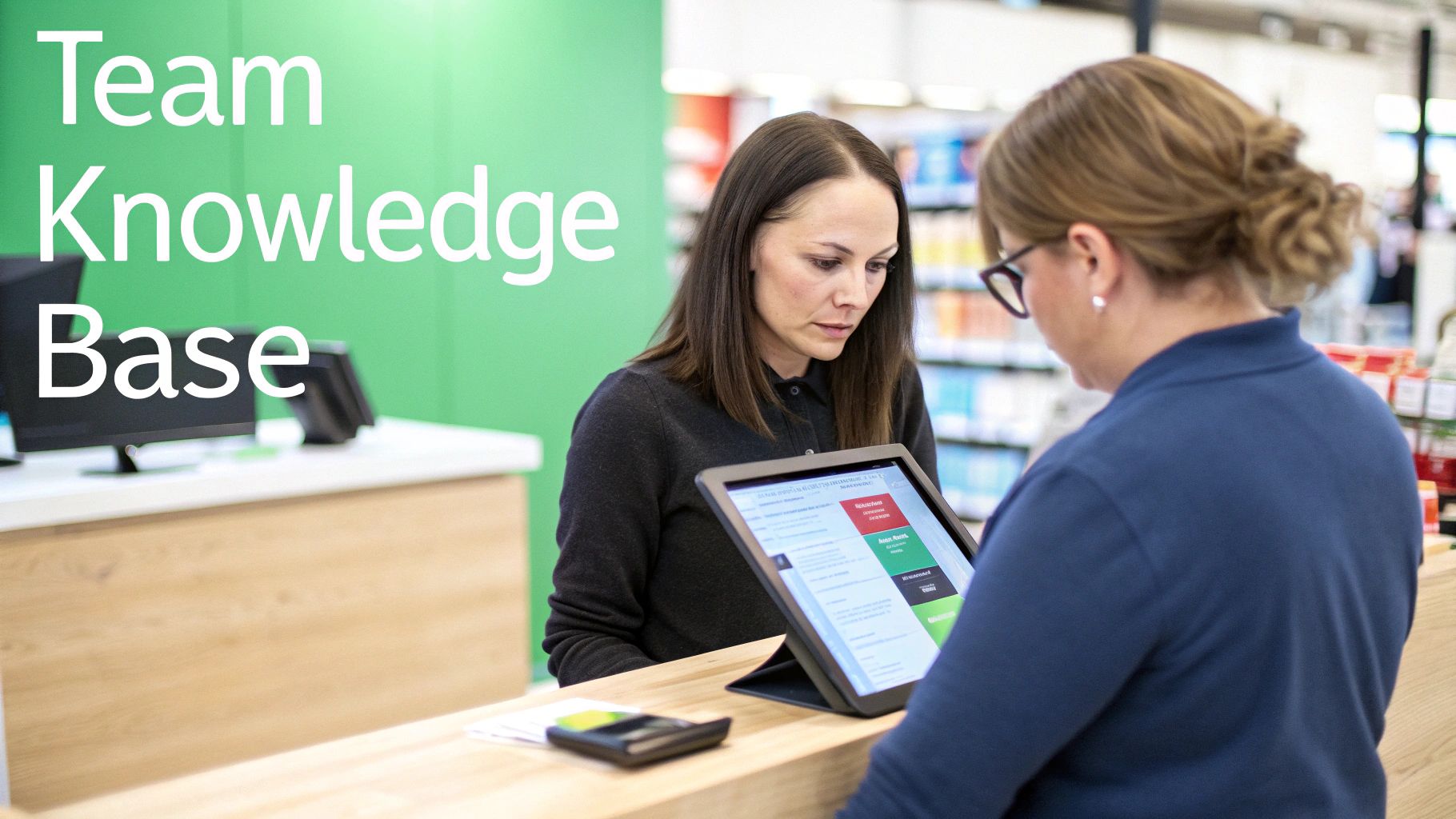
A world-class customer experience is only possible when your internal teams are as connected and informed as your external-facing systems. While Sitecore is brilliant at orchestrating the customer journey, a truly complete omnichannel strategy also needs to empower your employees.
This is where integrating a powerful knowledge management system like SharePoint becomes a game-changer. It bridges the critical gap between your customer-facing technology and the people who deliver your brand promise every single day.
Think of it this way: Sitecore is the director telling the actors (your channels) what to do and say to the audience (your customers). SharePoint is the script supervisor, making absolutely sure every actor has the same, most current version of the script.
Creating a Single Source of Internal Truth
The main job of SharePoint in an omnichannel setup is to act as the central knowledge base for your entire organization. Your customer service agents, in-store staff, and marketing teams all need instant access to the exact same information that’s driving the digital experience.
Without it, consistency just crumbles.
Imagine a customer asks your website's chatbot a specific question about a product warranty. They get a clear answer powered by Sitecore. Then, they call a service agent who gives them conflicting information. That disconnect erodes trust in an instant.
By integrating SharePoint, you lock in consistency. You ensure that:
- Product specifications and marketing materials are identical everywhere.
- Company policies and return procedures are consistent across all touchpoints.
- Training materials are universally accessible to every employee.
This creates a unified front. The information a customer finds on your website will perfectly match what they hear from an employee in a store or on the phone.
Practical Integration Use Cases
The real power here emerges when SharePoint content is pulled directly into the other operational systems your teams use, often powered by data from Sitecore. A smart integration makes your internal data accessible and actionable, which is a cornerstone of effective SharePoint solutions.
For instance, a customer service dashboard built on Sitecore can be set up to pull relevant documents straight from a SharePoint library. When an agent views a customer's profile—seeing their recent purchases and browsing history—the dashboard could simultaneously display:
- The specific user manuals for the products they own.
- The latest training modules related to their support query.
- Internal FAQs about common issues with those items.
This practical link transforms SharePoint from a passive file cabinet into an active, intelligent tool that supports your teams in real-time. It ensures every employee has the precise information they need to resolve issues quickly and accurately, reinforcing the seamless experience your customers expect.
Measuring the Business Impact of Your Omnichannel Strategy
An omnichannel experience is far more than a nice-to-have, customer-friendly philosophy. It's a direct and powerful driver of business growth. While your main goal is to create a seamless journey for the customer, the result for your business is a set of tangible, measurable outcomes that prove the return on investment.
This is where your unified strategy starts paying real dividends. By connecting every touchpoint, you kickstart a flywheel effect on your most important key performance indicators (KPIs). The focus shifts away from siloed, single-channel metrics and moves toward a holistic view of customer health and profitability. You’re no longer just trying to make an experience feel good; you’re building a strategic financial asset.
Key Metrics to Track for Omnichannel Success
Platforms like Sitecore are built not just to create these experiences but to measure them effectively. With analytics that pull from a unified customer profile, you can see the direct impact your efforts have on the metrics that matter most.
These are the KPIs that really tell the story of your omnichannel success:
- Customer Lifetime Value (CLV): When you recognize customers across every channel and personalize their journey, you build the kind of loyalty that keeps them coming back. A rising CLV is a direct result of that sustained engagement.
- Average Order Value (AOV): Understanding a customer's full history lets you make smarter, more relevant recommendations. That naturally leads to larger, more profitable purchases.
- Customer Retention Rate: A smooth, friction-free experience gives customers fewer reasons to look elsewhere. Better retention is one of the clearest signs that your omnichannel strategy is hitting the mark.
Tracking these metrics is essential. It moves the conversation from "Are our customers happy?" to "How is this unified experience driving measurable revenue and loyalty?"
The Financial Proof Is in the Numbers
The financial upside of a well-executed omnichannel approach isn't theoretical; it's well-documented and significant. Companies with strong omnichannel strategies see an average annual revenue growth rate of 9.5%. That's more than double the 3.4% growth seen by firms with weaker, less integrated approaches. On top of that, these companies also manage to reduce their cost per customer contact by 7.5% year-over-year.
The data gets even more compelling. Omnichannel customers tend to visit physical stores 80% more frequently and spend 4% more per visit than single-channel shoppers. You can dig into more omnichannel shopping statistics to get the full picture of just how impactful this can be.
With a platform like Sitecore, the analytics dashboards make it possible to connect all these dots. You can directly attribute revenue and engagement to specific moments in the customer journey, giving you the concrete evidence needed to justify continued investment and fine-tune your strategy with real-world performance data.
Omnichannel Questions Answered
When you start digging into what an omnichannel experience really means for your business, a few practical questions always pop up. Getting these sorted out is key to building a strategy you can feel confident about. Here are some straightforward answers to the questions we hear most often.
What Is the First Step to Building an Omnichannel Strategy?
Before you do anything else, you have to unify your customer data. That’s the non-negotiable first step. You can't create a seamless journey if you don't have a single, coherent view of each customer. This means tearing down the data silos that prevent your channels from talking to each other.
The most effective way to do this is by implementing a Customer Data Platform (CDP) like Sitecore CDP. Think of it as a central hub that pulls together every interaction from every touchpoint—website visits, mobile app usage, in-store purchases, support calls—into one complete profile. This unified profile can then be shared across your entire tech stack, making everything work together.
Can Small Businesses Implement an Omnichannel Experience?
Absolutely. The trick for smaller businesses is to start smart, not big. Don't fall into the trap of trying to integrate every possible channel right out of the gate. Instead, pick the two or three customer journeys that matter most and focus on making the handoffs between them perfect.
For example, a great starting point is connecting your e-commerce site with your in-store point-of-sale system. A composable platform like Sitecore is perfect for this, as it lets you add new tools and integrate more channels one by one as your business grows and your needs change.
How Does a Composable DXP Help with Omnichannel?
A composable Digital Experience Platform (DXP) is practically built for the kind of flexibility a true omnichannel experience requires. Instead of forcing you into a one-size-fits-all suite, a composable architecture lets you handpick the best tools for your specific needs and plug them into a single, cohesive system.
This approach means you can connect Sitecore’s powerful CDP and personalization engine with other essential systems, like a SharePoint knowledge base for your internal teams or your existing e-commerce platform. It gives you an adaptable framework to build a powerful and scalable omnichannel operation that’s tailored to your business goals, not a vendor's. This flexibility is what allows your system to evolve right alongside customer expectations.
Ready to build a truly seamless customer journey? The experts at Kogifi can help you design and implement a powerful omnichannel strategy using Sitecore and SharePoint. https://www.kogifi.com

















